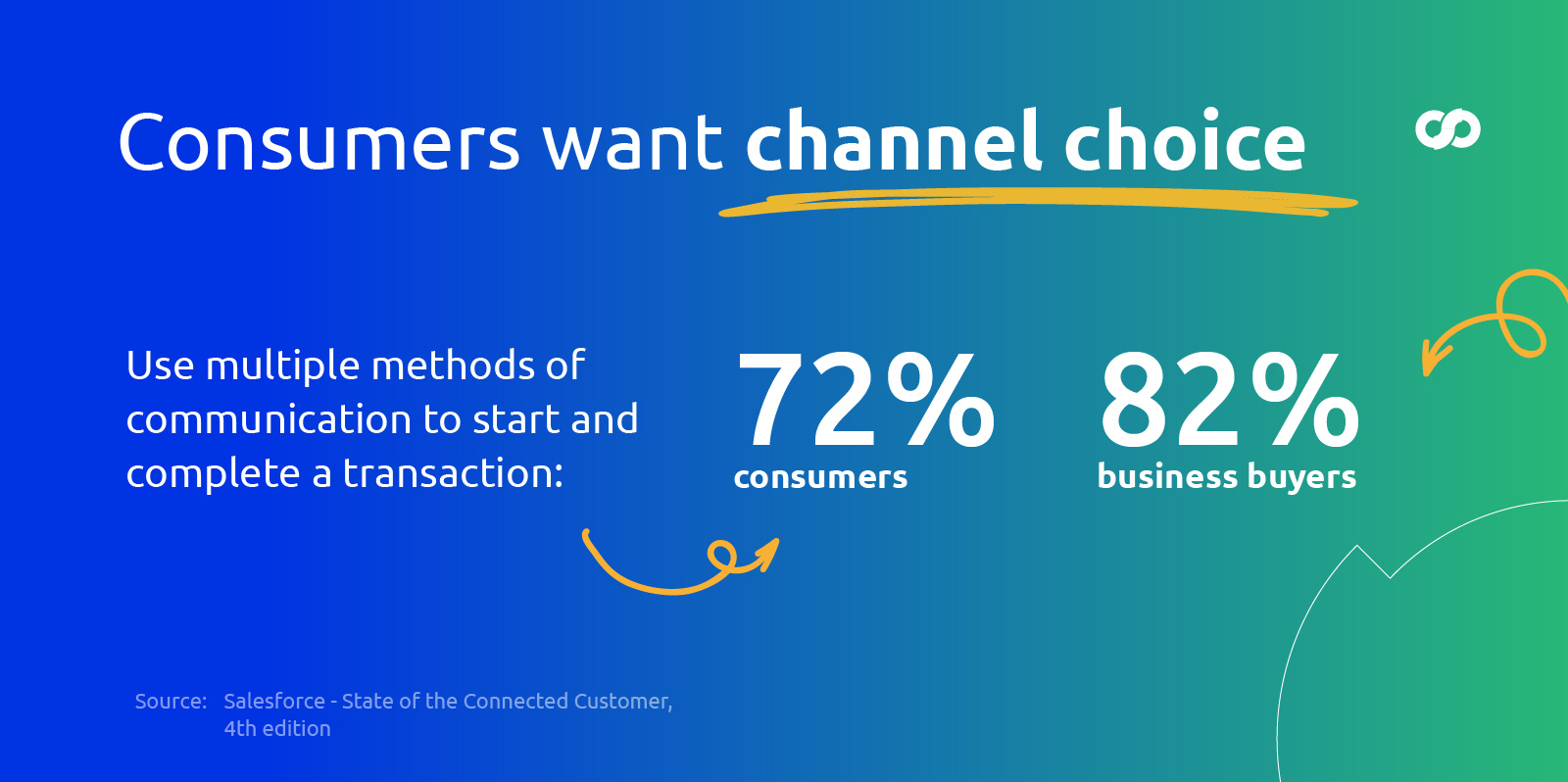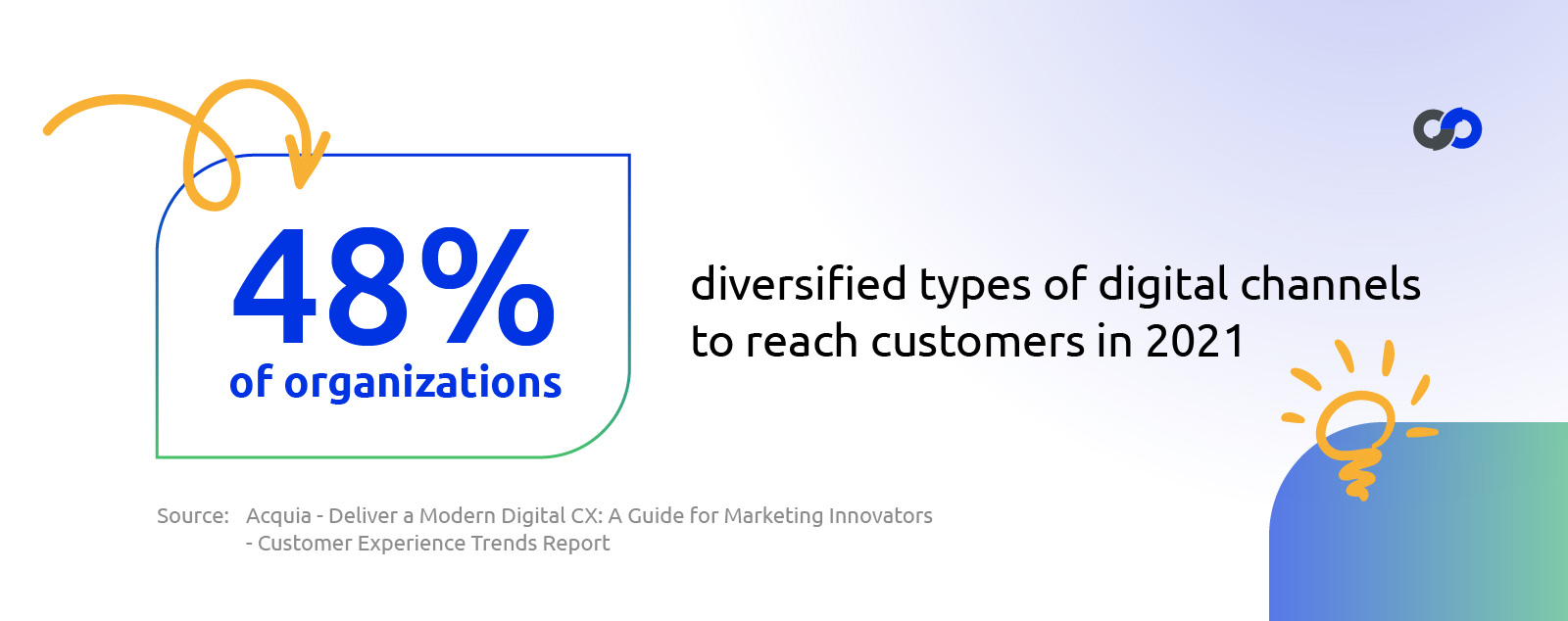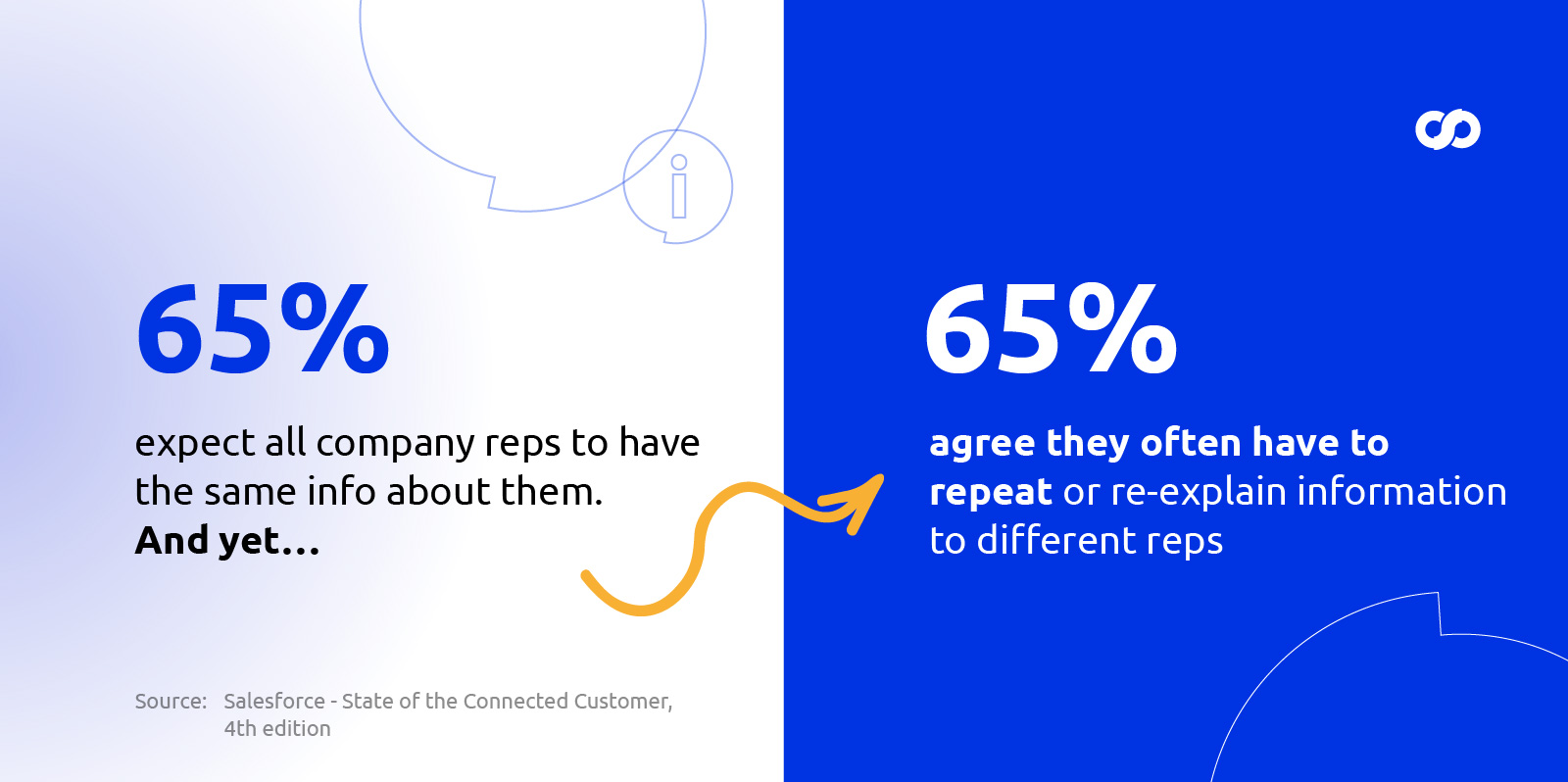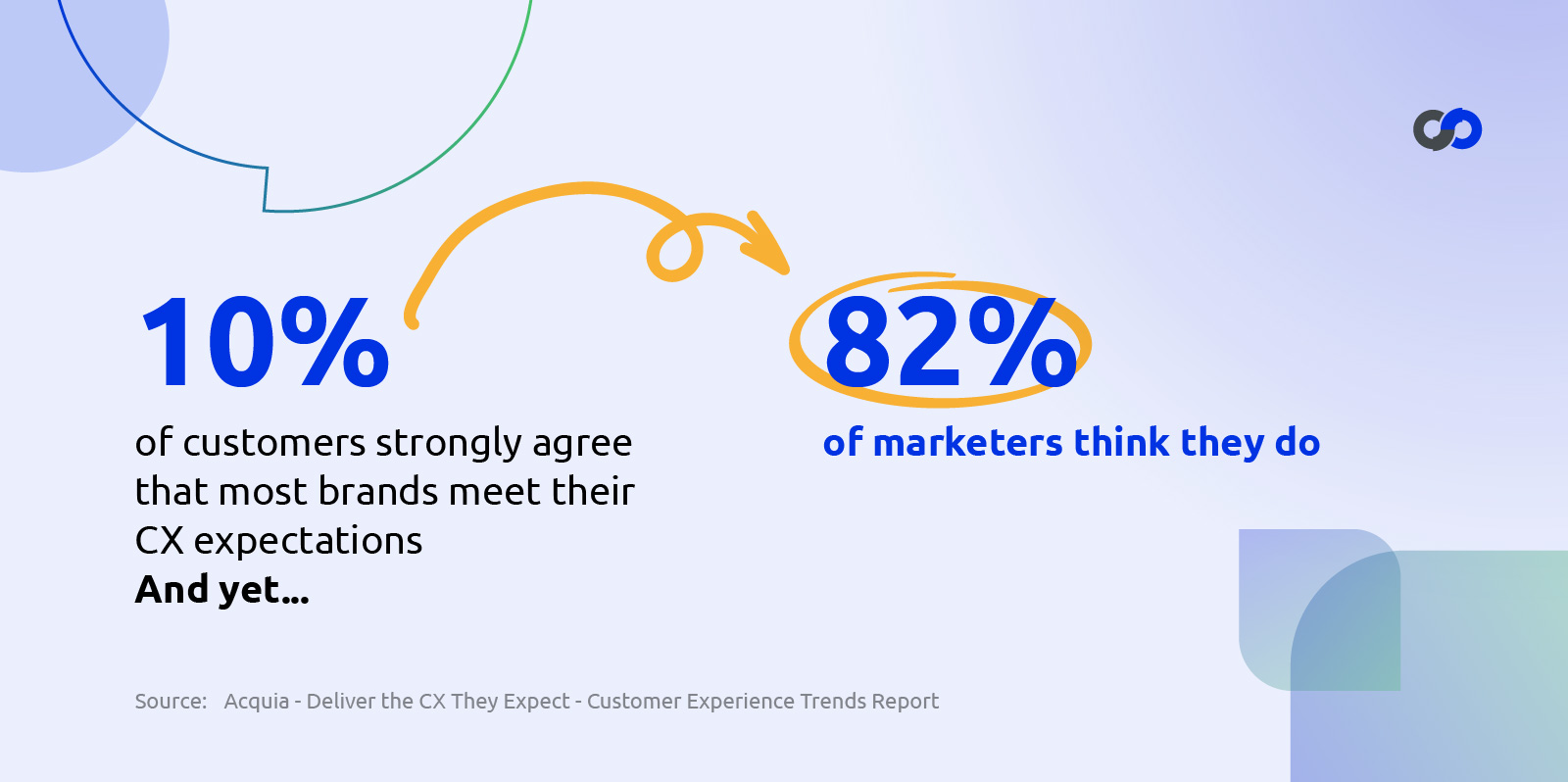Live webinar: Cut costs, grow revenue - Discover the new Comm100 AI trifecta ✨
Register nowLive webinar: Cut costs, grow revenue - Discover the new Comm100 AI trifecta ✨
Register nowThe state of customer service is always changing, and brands must keep up. While offering just phone or email support was once accepted, consumers today expect far more. Customers now use an average of nine different channels to connect with companies, and they expect the support they receive on these channels to be fast, convenient and personalized. Supporting customers across all these channels isn’t always an easy feat, but there are tools that can solve the problem.
By introducing omnichannel customer support, organizations can effectively serve customers across all the channels they expect, in the manner that they now demand. Omnichannel customer support software connects every digital channel into a unified platform, bringing improved efficiency and CX, to name a couple of its many benefits.
If you’d like to learn how omnichannel customer support can transform your operations, this guide is the best place to start. We’ll explain everything you need to know about omnichannel support, including the key benefits of omnichannel, example use cases, what to look for in omnichannel software, and the best platforms available. To begin, let’s look at what omnichannel customer support is and how it works.

Today’s consumers are no longer satisfied with organizations offering just one or two customer service channels. They now want to reach out to brands on a variety of channels depending on what suits them in that moment – whether that’s live chat, email, social media or even SMS. Research shows that 72% of consumers use multiple communication channels when completing a transaction, rising to 82% for business buyers.

Juggling all these channels while delivering efficient and connected support is difficult, and often impossible. How can you expect your support agents to deliver fast and helpful support in a set up where they have to switch between various systems and customer information is siloed within channels? This is where omnichannel customer support comes into play.
Omnichannel customer support software connects every digital channel into one platform and unified inbox. Whether a customer texts, emails, or live chats, the query will be funnelled into the agent console. Just as importantly as drawing each channel together, omnichannel customer support also draws all your customer information together too. When a customer sends a message, a wealth of information about them is displayed to the agent who picks up the query – conversation history, previous purchases, location and much more.
This access to information doesn’t just help the agent to respond faster – it also empowers the agent to deliver more helpful and personalized support. And you can say goodbye to forcing customers to repeat their problem to different agents too. (More on the benefits of omnichannel customer support in Chapter 2).

Meet your customers’ CX expectations with Comm100 Omnichannel – the AI-powered, secure omnichannel customer engagement platform.
When discussing what is omnichannel customer support, it’s vital to distinguish its differences to multichannel support. Multichannel support can appear similar to omnichannel, but in practice the difference is night and day.
Multichannel support refers to companies interacting with customers through multiple channels with each channel managed in its own platform. Omnichannel support, on the other hand, blends these channels with one another and manages them all from a single, unified console. Organizations using multichannel support face a number of problems.
Firstly, from a practical point of view, disconnected channels make life more difficult and time-consuming for agents as they have to constantly switch between applications. Worse still, because the information is siloed within each channel, these agents can’t provide as helpful support because they simply can’t access the information they need to answer the query, or at least answer it quickly. And when a customer switches channels (as they frequently do), the agent doesn’t have access to their previous conversation history, so forcing the customer to repeatedly repeat their query.
There is no doubt as to the winner of omnichannel vs multichannel support. The CX that customers receive with omnichannel customer support is far superior.
When searching for omnichannel platforms, you may find yourself asking – ‘what is omnichannel customer engagement?’. This term is often used synonymously with omnichannel customer support, but it can also refer to a greater focus on engaging with customers at all stages of the buyer journey, rather than just providing customer support post-purchase. However, the same principle applies – connecting every channel together to provide a seamless customer experience.
Now that we’ve answered the question “what is omnichannel customer support?” and taken a look at omnichannel vs multichannel support, it’s worth exploring the channels that are typically stored within an omnichannel platform. The most common channels supported within omnichannel customer support software are:

As organizations increasingly recognize the need to offer a range of communication channels, the benefits of omnichannel customer support become apparent. Connecting your digital channels into one platform leads to improved efficiency, CX, and ROI. It’s worth exploring the benefits of omnichannel customer support in greater detail, so in this chapter, we’ll look at the key reasons why organizations are adopting omnichannel customer support.
Customers today stay connected across a variety of channels, and they are no longer content with customer service that limits how they get support. These customers want to use the channel that suits them in that moment, and organizations are taking note. In 2021, 48% of organizations diversified the types of digital channels they used to reach customers.
One of the key benefits of omnichannel customer support is the ability to support customers according to their preference. With a single platform connecting every channel, customers can reach out using SMS, live chat, email, or social media, and receive the same excellent service no matter the channel. With omnichannel, customers can also just as easily change channels during support based on their needs or preferences and pick up right where they left off. We’ll explore this more below.

Omnichannel support doesn’t just connect every channel together – it connects all the information within those channels. This provides agents with a wealth of information that empowers them to provide more helpful and accurate support to every customer. This sharing of information is made more important with the understanding that 65% of customers expect all representatives in an organization to have the same information about them.
With access to a unified inbox, agents can understand how each customer interaction fits into that customer’s history. This can be even further improved with the integration of a CRM like Salesforce or other business systems, offering even more information to agents. Connecting a CRM also allows agents to make updates to CRM records right from inside the agent console, improving data quality for future interactions.

A key benefit of omnichannel customer support is speed and efficiency. With a 360-degree view of every customer available at their fingertips, agents don’t need to waste time switching channels and searching records to understand the bigger picture. Instead, agents can quickly glimpse a customer’s records and respond to their query.
Speed is among the most important benefits of omnichannel customer support because it helps inform how a customer views their entire customer service interaction. Research shows that 80% of American consumers rate speed, convenience, and knowledgeable help as the most important elements of a positive customer experience, and omnichannel customer support provides all three. As support teams using omnichannel customer support software can handle queries faster, customers also enjoy reduced wait times.
The efficiency created by omnichannel customer support is further improved by integrating a knowledge base. Agents can easily search for and retrieve the answers they need without leaving the platform.
Customer support teams that manage multiple channels often experience data silos between their channels. This has become a significant problem as organizations add new channels, and research shows that data silos are now a persistent challenge for 90% of organizations. Siloed data can cause issues in customer service transactions such as:
Because omnichannel customer support connects every channel together, all the information is connected too. With information sharing in omnichannel customer support, organizations can get a more complete and accurate view of not only customers, but also support teams and how they are functioning.
Omnichannel customer support allows your agents to provide the best support possible by letting your agents use the right channel for the job. If a customer reaches out on social media about a billing issue that would be better resolved over email, omnichannel support lets agents easily shift the conversation to a new channel without the need to start over.
For situations where confidential requests need to be moved away from Twitter and other public channels, omnichannel customer support software allows agents to simply suggest moving the conversation to another channel. If the customer agrees, the agent can change the channel using a dropdown menu in the chat window, moving the conversation seamlessly to the new channel. When customers initiate these channel switches themselves, omnichannel lets agents keep up just as seamlessly, tracking the full conversation in a single chat thread.

Organizations often struggle with meeting customer expectations. One study found that while 82% of marketers think they’re meeting customer needs, only 10% of customers agree that their CX expectations are being met. To overcome this disconnect, customer service teams need a better understanding of their customers, which omnichannel customer support can provide. In this chapter, we’ll look at some of the ways industries are using omnichannel customer support.

Reaching prospective students can be a challenge for any college admissions team. By introducing omnichannel support, admissions teams can increase engagement opportunities with prospective students across more channels and ensure they’re never missing a follow-up. Whether it’s supporting the latest social app or live chat on your website, omnichannel means that admissions teams can offer more channels and prospective students can trust they’ll receive a response.
Integrating a chatbot with omnichannel support also creates new ways to engage international applicants. With a chatbot providing 24/7 support across all channels, international students can reach out when and how they see fit, from any time zone. The addition of built-in chat translation means that a chatbot can respond to students from just about anywhere.
Credit unions face tough competition today thanks to new online options for financial customers. To remain competitive, credit unions need to offer more personalized and helpful member support. By connecting every channel through an omnichannel platform, credit union agents can benefit from improved data insights to provide more personalized support and display more care for members during interactions.
For credit union agents, the shared information from omnichannel means understanding more about member investments, physical branch visits, web page visits, and more. This focus on customer care and insights meets the needs of credit union members, with 67% of Gen X saying that they “expect companies to understand my unique needs and expectations”. For credit unions this can also mean improved business, as engaged members have been found to spend 22% more than non-engaged members.
In a fast-paced industry like healthcare, time is money for both customers and providers. To see better service in less time, healthcare providers can introduce omnichannel support to cut down on the time agents spend searching for client information. With all channels connected and sharing information, agents can quickly access previous conversations to understand client history.
By removing the need for clients to repeat themselves, agents can provide support that is much faster and more personal. For in-office visits, omnichannel support can mean getting clients out the door faster. For remote support, omnichannel can help agents close queries more quickly so they’re ready for the next client.
For customers navigating complex services like those offered by the insurance industry, reaching the right person the first time is critical to a positive customer experience. By introducing omnichannel customer support, insurance companies can use advanced routing rules to ensure that no matter what channel the customer reaches out on, they’re routed to the best agent, team, or department.
With customers automatically routed to the best person for their query, omnichannel provides a better, smoother, and faster experience, and enables companies to direct messages based on value. This could mean a low value, frequent question gets answered by a chatbot based on routing rules, while a high value sales opportunity is routed to a senior sales agent.
Everybody has their preferred way of communicating. Some people want to reach out via live chat, some social media, and others via email. The beauty of Comm100 is that every channel can be connected into one platform so we can connect with and support more students, more efficiently.
– Lachlan Todd, Communications & Systems Coordinator, Thompson Rivers University

Meet your customers’ CX expectations with Comm100 Omnichannel – the AI-powered, secure omnichannel customer engagement platform.

By now you will have realized that there are many factors to consider when choosing an omnichannel customer support software. From security, to personalization, and automation, this chapter reveals some of the most important features and considerations that you should look for when researching vendors.
Selecting omnichannel customer support software begins by evaluating the security and compliance of each platform. Beyond a legal requirement, choosing the best option in omnichannel platform security can help to build trust with your customers. This trust can help to win future business, as customers today know that security is no longer a given. In fact, only 21% of consumers said they believed that established global brands would keep their personal information safe.
When choosing an omnichannel customer support software, look for enterprise-grade security that meets international security and privacy benchmarks, particularly focusing on:
Platforms that meet these compliances demonstrate a commitment to data security by adhering to rigorous guidelines and policies. ISO 27001 and SOC 2 Type II are both recognized worldwide, and organizations meeting these standards must pass external audits from accredited certification bodies. Depending on your industry and location, you may also need to look for other security compliances such as HIPAA for healthcare, GDPR for Europe, and PIPEDA for Canada.
To ensure the security and reliability of your data, you should also look for security features that follow industry best practices. These features will help to mitigate risks to your organization and your customers:
As mentioned earlier, omnichannel customer support software is uniquely positioned to provide customers with a personalized experience. Offering personalized service can become a major factor in winning new business, as 66% of customers said they would switch brands if they felt they were being “treated like a number, not an individual”. The desire for personalization in customer service isn’t surprising given that only 10% of customers strongly agree that most brands meet their CX expectations.
To offer truly personalized support, your agents need the unified console of omnichannel to easily view all your consolidated customer information. Maintaining accurate data also means that your agents need the ability to easily update customer information on the fly. With CRM integration, agents accessing an omnichannel platform can easily update customer contacts, preferences, and other details to ensure excellent future outcomes.
Personalization in omnichannel goes a step further when you introduce chat routing by customer segmentation. With segmentation and routing rules, you can label your visitors based on pre-defined rules to ensure the best agents responds each time. This could take the form of international support teams designated to specified geographic regions, or individual agents assigned to VIP website visitors.
The value of AI automation introduced to an omnichannel customer support software should not go overlooked. More than just responding to requests, AI automation can introduce agent tools that drive efficiency and improve outcomes. As customer requests come in, AI-powered agent assist tools can recommend appropriate knowledge base articles or other resources. By putting resources at an agent’s fingertips, those agents can respond faster and with a higher degree of confidence. This feature also helps to train new staff that may still be learning your products and services.
While you may not be ready to introduce chatbots and automation when first implementing omnichannel customer support software, it’s best to plan ahead and select a platform that offers chatbots. While you can often integrate third party chatbots to another omnichannel platform, this can cause complications down the road, meaning it’s best to find an omnichannel platform offering its own chatbot.
To ensure the easiest upgrade path, look for omnichannel platforms that offer a variety of chatbot types. This includes basic bots as well as more advanced AI chatbots so that you can upgrade your bot when you’re ready.
Omnichannel customer support software is excellent at capturing customer insights and understanding how your agents and campaigns are performing. To make the most of these insights, it’s important to evaluate the reporting capabilities of any chosen platform. Detailed reports to look for include:
The power of omnichannel customer support software lies in the ability to leverage data, but this can only be achieved through integrations with other applications. A variety of integrations will ensure that your solution is flexible and future-proof when upgrading your other systems. Important integrations to consider when selecting the best omnichannel customer support solution include:
Finally, when adding to your own support capabilities, you shouldn’t overlook the support provided by your own vendors. Make sure that your agents can receive support during their working hours, including 24/7 support if possible. As we’ve already seen, support offered across a variety of channel options is best.
To learn more, check out this shopping checklist for omnichannel customer engagement platforms.

Based on the criteria seen in the last chapter, we’ve assessed some of the best omnichannel customer support software. Listed here in alphabetical order are four of the best omnichannel customer support software on the market:
Headquartered: Vancouver, Canada
Founded: 2009
Comm100 is a global provider of digital omnichannel customer engagement software for education, government, and commercial organizations of all sizes. With Comm100, organizations can provide excellent digital customer experiences through configurable, value-driven live chat, secure messaging, AI powered bots and automation within one integrated console. Comm100 is powered by zero downtime, the highest standards in security, and AI automation, ensuring customers get answers anytime, anywhere.
Headquartered: Boston, Massachusetts, United States
Founded: 2015
Drift’s Conversation Cloud omnichannel solution enables businesses to connect with customers more effectively for marketing, sales, and service. Their platform promises a personalised experience that can lead to increased marketing conversions and revenue, and improved customer interactions. Conversation Cloud supports a variety of partner integrations and product features like visitor insights and lead form automation that make for a robust solution.
Headquartered: Daly City, California, United States
Founded: 1990
Genesys strives to deliver on a vision for empathetic customer experience at scale. Their omnichannel platform is designed to foster customer trust and loyalty, while introducing increased efficiencies. With a variety of built-in technologies like live chat, chatbots, SMS support, and more, this omnichannel platform offers a wide variety of ways for customers to connect.
Headquartered: San Francisco, California, United States
Founded: 2011
Intercom, the Engagement OS, provides an omnichannel platform that enables stronger customer relationships while driving growth. Their solutions are built for sales, marketing, and support teams to work together and engage customers throughout their journey. This focus on the big picture means that Intercom is best for organizations looking to track the entire customer lifecycle.
For a full breakdown on these 4 contenders, continue reading here: The Best Omnichannel Customer Support.
Offering a variety of customer service channels is vital. Simply providing telephone and email support doesn’t cut it anymore. In order to manage these channels efficiently and effectively, an omnichannel customer support software is crucial. Find out how Comm100 Omnichannel could be the platform for you.

Meet your customers’ CX expectations with Comm100 Omnichannel – the AI-powered, secure omnichannel customer engagement platform.
There’s a lot more where this came from!
Get our monthly customer service news and best practices update delivered to your inbox.

Article by
Kate is the Content Marketing Specialist at Comm100. She has extensive experience in content creation for technology companies across the world, including the UK, Australia and Canada. She specializes in B2B messaging, branding and soccer trivia.